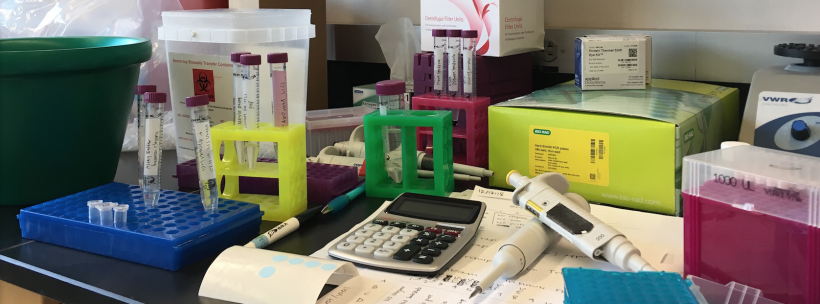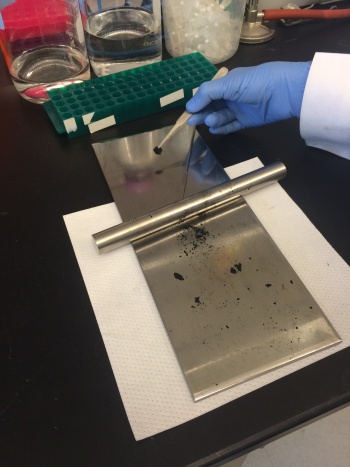20.109(S19):Construct cathode with phage-based active material (Day3)
Contents
Introduction
Batteries are composed of one or more electrochemical cells that convert chemical energy into power, specifically electrical energy. A single battery consists of two electrodes – a positive electrode termed the cathode and a negative electrode termed the anode. These electrodes can be further defined by their roles during discharge of the battery. The cathode accepts electrons and the anode donates electrons as the battery is discharging. As the current flows, electrons move toward the cathode with ions from the electrolyte solution. Though this movement is reversed when a secondary (or rechargeable) battery is recharged, the positive electrode is still referred to as the cathode, and the negative electrode the anode in the literature.
Capacity is defined as the amount of charge that is stored by a battery. In general, the more electrode material contained within the battery the greater the capacity. However, if the electrode is too big, the electrolyte solution is unable to penetrate, which may impede the current flow required for the battery to perform work.
Today's lab will focus on synthesizing the material needed to construct your battery. You will assemble your nanowires into a battery electrode by mixing a known percentage of active nanowire material, with conducting material and binding material. The conducting material we will use is a graphite carbon called “Super P”. The binder is a type of teflon called polytetrafluoroethylene, or PTFE for short, that will hold the nanowires and carbon conductor together. The nanowires, carbon, and teflon will form a flexible film that you will roll into a sheet and use to construct the cathode for your battery. Later in the module, the cathode will be moved into a glovebox to be assembled with the lithium anode and the electrolyte, and lastly pressed into a coin-type casing.
Protocols
Part 1 of today's lab protocol will require that we work in small groups in the Belcher lab. You will use their balance to measure very small masses of material and their glove box to assemble your batteries. As visitors to their lab, please be respectful of their time, equipment, and space. Because you will be completing laboratory work in the Belcher Lab, it is important that you take goggles and a lab coat with you.
Part 1: Construct cathode with active material (nanowires)
In this part of the protocol you will need to make some careful mass measurements and then mix your nanowires with carbon (Super P) and teflon 8A (PTFE) at the correct ratio of 60% active material (nanowires), 35% Super P, and 5% PTFE. These materials will be mixed into a homogeneous powder and this powder is what will be used to make the battery electrode (specifically, the cathode).
- Weigh the dried active material that you prepared during the previous laboratory session.
- Carefully transfer the material to a sheet of weigh paper on the analytical balance.
- Calculate the amount of Super P and PTFE you will need to add to your active material.
- The final cathode material should be composed of 60% active material, 35% Super P, and 5% PTFE.
- Use the weight you measured in Step 1 to determine how much Super P and PTFE is needed.
- Confirm your calculations with the teaching faculty before moving to the next step.
- Weigh out the appropriate amount of Super P (the weight you calculated in Step 2).
- Transfer the active material and Super P to a mortar and grind with the pestle to mix, by moving the pestle in a circular motion.
- Grind for 5-6 minutes.
- To ensure the mixture is homogeneous, use a clean spatula to scrape down the sides every minute.
- Weight out the appropriate amount of PTFE (the weight you calculated in Step 2).
- Add the PTFE to the top of your piled active material + Super P mixture and mix together.
- Transfer your active material, Super P and PTFE mixture to the center of a steel plate. Note: it is helpful to put the steel plate on a paper towel as this will prevent the plate from sliding on the benchtop while you roll your material.
- It is best to keep the mixture as a pile.
- Use the roller to roll out the mixture.
- Firmly press the roller into the pile while 'rolling' the mixture into a flat sheet.
- To ensure the mixture is homogeneous, use a clean spatula to scrape the cathode material back into a pile and 're-roll' it into a flat sheet.
- Repeat this process a total of 5 times.
- When the active material, Super P, and PTFE are thoroughly combined, roll your cathode material into a very thin sheet.
- To ensure the cathode material is evenly rolled into a thin sheet, roll from various directions (i.e. up and down, left to right, corner to corner). If your sheet is too thick the electrolyte will not penetrate your cathode.
- Be careful not to crack the sheet...you want a thin, flat, continuous sheet.
- Use the 3/8" punch to create your cathode disc.
- Place the punch on your rolled cathode material.
- Press firmly down on the punch.
- Lift the punch. The cathode material should be stuck to the end. Use tweezers to 'pick' away the excess cathode material, being careful to leave your disc undisturbed.
- Use the tweezers to 'peel' your cathode from the punch and weigh your the disc on the analytical balance.
- Ideally, your disc will weigh 2-3 mg. If it is too big, roll your remaining sheet of cathode material thinner and try again. If it is too small, pile your remaining cathode material and try again.
- Record the weight of your cathode on a clean glass vial.
- Clearly label the vial with your group information.
- Carefully transfer your cathode disc to the labeled vial.
- Cover the vial with aluminum foil and poke a small hole in the top.
- Place your vial in the vacuum drying oven set to 80°C.
Part 2: Research proposal review exercise
To help you focus your ideas and develop the details of your project, you will discuss the project description you submitted today with a classmate from another group. As you listen to your classmate's idea, consider the following criteria proposed for small research project grants by the NIH:
Small Research Grant Program: ...small grant supports discrete, well-defined projects that realistically can be completed in two years and that require limited levels of funding. Because the research project usually is limited, the grant application may not contain extensive detail or discussion. Accordingly, reviewers should evaluate the conceptual framework and general approach to the problem. Appropriate justification for the proposed work can be provided through literature citations, data from other sources, or from investigator-generated data. Preliminary data are not required, particularly in application proposing pilot or feasibility studies.
Use the following exercise to guide your discussion as you consider both your and your classmate's project. Because you are still in the early stages of developing your research topic, it is okay if you do not have all of the answers to the following questions. This is meant to help you critically think about your proposal...not to point out the additional research you need to complete! Furthermore, this is an informal conversation and you should feel free to look up information during this exercise or just make notes so you know what to research later with your co-investigator.
Outline of the peer review exercise:
- Find the partner you were assigned by the teaching faculty and begin by deciding which partner will present first.
- As the presenter, focus on why you believe your topic is important and provide the context needed to convince your listener that it is indeed worth pursuing.
- As the listener, verbally summarize the topic back to the presenter to ensure you understood the proposal. Are you convinced that the topic is important? Why or why not? Discuss this with the presenter.
- Now that you have the needed background information discuss the 'Hows' of the project.
- As the presenter, consider the questions below as you give some details about your proposal.
- As the listener, feel free to ask questions and maybe provide some helpful feedback as the presenter discusses the details of their project.
Questions to guide your discussion:
- What is the novel aspect of your proposal?
- Why do you believe your project is feasible?
- Is there evidence that supports your proposal?
- How will your research advance the field?
- How will you complete your research (what methods might you use)?
- What is the expected result?
- How might you 'double-check' or confirm an expected result?
- What if you do not get the expected result?
- What can be learned if you get the expected result? If you get an unexpected result?
- What are some alternative approaches (methods) for your proposed research?
Once you have completed discussing the presenter's project, switch roles and complete this exercise with the listener's project.
Use the information you gathered during this exercise to drive a discussion with your co-investigator as you further develop your research proposal and prepare the homework assignment due on Day 4.
Reagents
- Super P Li from TIMCAL
- Teflon 8A (PTFE) from DuPont Fluoropolymer
Next day: Visualize phage nanowires using transmission electron microscopy
Previous day: Purify phage-based active (cathode) material
